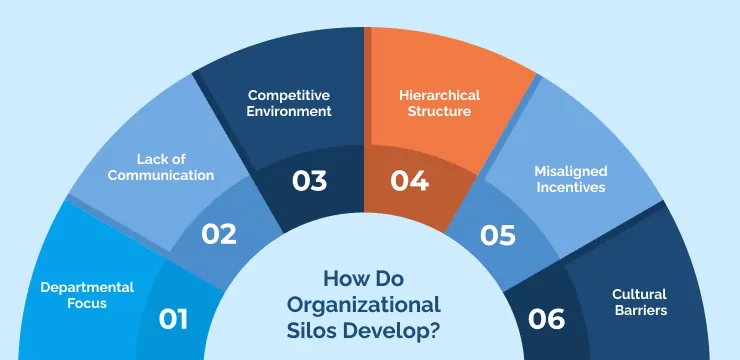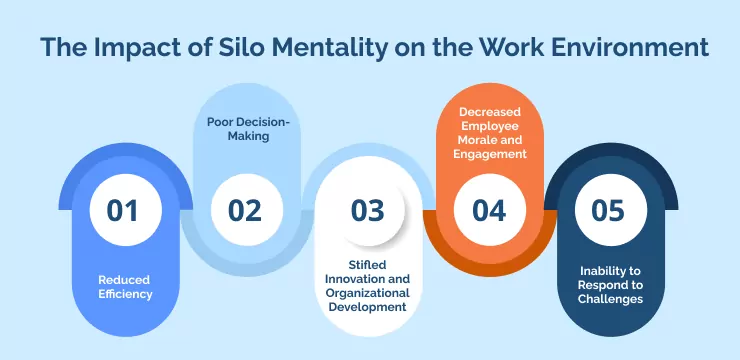
Agility, collaboration, and near-instant communication are vital components that drive progress in today’s high-octane business arena. However, a lurking challenge known as silo mentality can impede organizational development, stifle innovation, and hinder a company’s ability to reach its full potential.
This insidious mindset, characterized by isolated departments and a lack of cross-functional communication, can create barriers to effective collaboration and information sharing. Research shows that 86% of respondents blame lack of collaboration or ineffective communication for workplace failures.
With the demand for an agile workforce increasing as a response to the digital disruption of recent years, it becomes increasingly important to address instances of silo mentality and dismantle obstructions to employee productivity.
In this article, we delve into the complexities of silo mentality, exploring its causes, consequences, and, most importantly, the solutions to overcome this organizational obstacle and foster a thriving, interconnected workplace.
By recognizing and proactively addressing these issues, companies can ensure a smooth transformation, allowing for greater adaptability, enhanced innovation, and a more successful and resilient enterprise.
What Does Silo Mentality Mean?
Silo mentality refers to a mindset where departments, teams, or individuals within an organization operate in isolation, focusing solely on their goals and objectives without considering the broader organizational context.
The term “silo” is derived from the agricultural storage structures that separate different types of grains. Similarly, a silo mentality creates barriers between departments or teams in an organizational setting, preventing the free flow of information, resources, and ideas.
How Do Organizational Silos Develop?

Organizational silos develop due to factors contributing to a lack of communication and collaboration within a company. These factors often stem from organizational structure, culture, and top-down management practices.
Let’s explore some of the key reasons behind the formation of silos in organizations:
- Departmental Focus: When departments or teams within an organization become too focused on their goals and objectives, they lose sight of the bigger picture. This can lead to a lack of understanding and appreciation for the roles and contributions of other departments, enabling an environment where cross-functional collaboration is limited.
- Lack of Communication: Inadequate communication channels or ineffective communication practices can exacerbate the development of silos. When information isn’t shared openly and transparently across the organization, it becomes difficult for employees to understand how their work fits into the overall strategy and objectives of the company.
- Competitive Environment: A highly competitive internal environment can create a mindset where departments or teams view each other as rivals instead of collaborators. This can lead to hoarding information and resources, further isolating individual units within the organization.
- Hierarchical Structure: A rigid hierarchical structure can contribute to the formation of silos as it often restricts the flow of information and decision-making authority. Employees may feel discouraged from sharing ideas or collaborating with colleagues outside their immediate team or department.
- Misaligned Incentives: If performance metrics and incentives are not aligned with the organization’s overall goals, it can encourage employees to prioritize their department’s success over that of the entire company. This can further entrench the silo mentality by discouraging cross-functional collaboration.
- Cultural Barriers: Differences in language, values, and social norms can create barriers to effective communication and collaboration between various teams or departments. A strong organizational culture that promotes inclusivity and open communication can help break down these barriers.
Organizations can create a more cohesive and trusting work environment by understanding the root causes behind the development of silos and actively working to break down these barriers.
The Impact of Silo Mentality on the Work Environment

Silo mentality can have several detrimental effects on the work environment, especially when individuals become conscious of the problem yet are incapable of initiating meaningful change.
This inhibits workflow, overall performance, employee engagement, and organizational development. Key consequences of silo mentality include:
- Reduced Efficiency: Departments operating in isolation can lead to duplicated work and inefficient use of resources.
- Poor Decision-Making: Limited access to information can result in decisions based on incomplete or outdated data, negatively impacting overall performance.
- Stifled Innovation and Organizational Development: A lack of cross-functional collaboration can hinder innovation and make the organization resistant to change, impeding growth and adaptability.
- Decreased Employee Morale and Engagement: Employees may feel disconnected from the broader organization, reducing job satisfaction and higher turnover rates.
- Inability to Respond to Challenges: A silo mentality can make it difficult for organizations to recognize and address potential threats or capitalize on new opportunities.
Organizational silos can significantly hinder a company’s ability to innovate, collaborate, and achieve its strategic objectives — ultimately fostering a lack of trust among employees.
Trust is a crucial element for successful teamwork and communication, and when it is compromised due to a silo mentality, the overall efficiency and effectiveness of the organization suffer.
Preventing the Emergence of Silo Mentality
According to Deloitte, employees who collaborate the most are happier and more cohesive than other workers. Highly collaborative employees are 17% more likely than low collaboration workers to feel that their new ideas are valued.
To prevent a silo mentality from developing within your organization, opt for a holistic approach to synchronize teams and break down barriers between departments. This approach enables business and change advocates to cultivate a collaborative environment supported by strong communication channels that promote interconnectedness and teamwork.
Key Strategies:
- Promote open communication through company-wide meetings, newsletters, or internal messaging platforms.
- Encourage cross-functional collaboration with joint initiatives, task forces, or team-building activities.
- Set goals and incentives by designing performance metrics to encourage collaboration and contribute to the company’s future success.
- Develop supportive leadership that values collaboration, inclusivity, and open communication.
- Break down hierarchical barriers by implementing flatter organizational structures and practices that facilitate open communication.
- Invest in organizational culture by promoting trust, teamwork, and shared values and providing resources to navigate cultural differences.
Overcoming Silo Mentality: Key Takeaways for a Collaborative Future
Quiet quitting is a phenomenon that occurs when an employee disengages from their job responsibilities and loses motivation to excel. This disengagement can stem from various factors, such as job dissatisfaction, poor management, or a silo mentality within the organization.
According to Gallup’s State of the Workplace 2023 Report, nearly six in 10 employees fall into this category. The report also shows when combined with actively disengaged employees, low engagement costs the global economy $8.8 trillion, or 9% of global GDP.
As such, nurturing a collaborative and inclusive environment is paramount to overcoming the silo mentality and maintaining marketplace viability. It essentially boils down to how effectively business and team leaders can cultivate open communication, cross-functional teamwork, and a shared vision among employees.
Always remember that organizational culture is an ongoing process requiring continuous investment. Regularly evaluate your company’s culture and proactively address any indications of a silo mentality.
By prioritizing these values and consistently monitoring your organization’s progress, you will not only dismantle existing silos but also prevent new ones from forming. Ultimately, this will lead to a more cohesive, agile, and successful organization that thrives in an increasingly interconnected world.
WalkMe Team
WalkMe spearheaded the Digital Adoption Platform (DAP) for associations to use the maximum capacity of their advanced resources. Utilizing man-made consciousness, AI, and context-oriented direction, WalkMe adds a powerful UI layer to raise the computerized proficiency, everything being equal.



